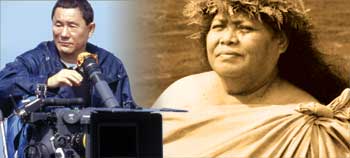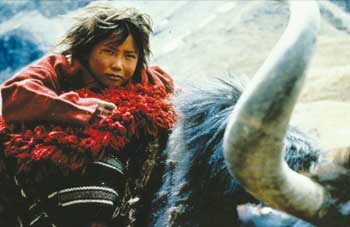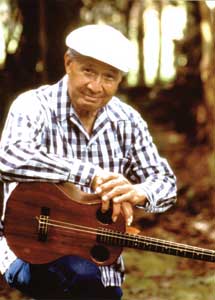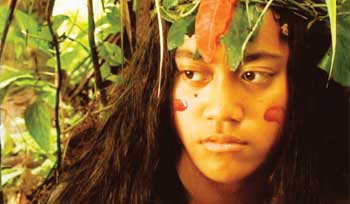![[Metroactive Movies]](/gifs/movies468.gif)
[ Movies Index | Show Times | Santa Cruz | Metroactive Home | Archives ]
Standing at the Crossroads
The Pacific Rim Film Festival returns for its 16th year of presenting the collision of identity, art and culture
By Peter Koht
The concept of the motion picture as a medium for social criticism is a pretty hard sell in Hollywood these days. While there are thousands of talented filmmakers around the world whose work is filled with sharp social comment, keen cultural observations and daring narrative strategies, most multiplex-goers usually get stuck dropping 9 bucks on such cinematic gems as Stealth and The Legend of Bagger Vance.
In the last two decades, an explosion of independent filmmakers has found both a venue and an audience in a circuit of film festivals whose focus falls on material more meaty than Jessica Biel's abs. But while Redford's efforts at Sundance have inspired a dedicated cable channel and a truly hilarious episode of South Park, the voices of many filmmakers from the Pacific Rim have been ignored in the American marketplace. To remedy this situation, a motley collection of local writers, critics and film fans organized the Pacific Rim Film Festival in 1988.
For the last 16 years, the festival has presented free screenings of movies by filmmakers from around the Pacific Basin. From the Aleutian Islands to the forests of Irian Jaya, this region encompasses innumerable societies. Yet their combined artistic endeavors suggest both the varied nature of indigenous cultural expression as well as the interconnectedness that trade and modernization have brought to geographically distant locales. "What we try to do," says Morton Marcus, a local writer, television host and member of the Pacific Rim Film Festival's Steering Committee, "is to promote understanding among the cultures of the Pacific Rim."
"The basic premise is to show a window on understanding another culture," says Jeanne W. Houston, another Steering Committee member and celebrated local author. "The higher ideal is that if we understand another culture, we can all get along."
Running Oct. 7-12, the festival will present 16 films whose artistic intentions explore culture, belief and change. From the elaborately staged period drama Stand Up for Justice, created by Japanese American filmmaker John Esaki, to the Hawaiian documentary Keepers of the Flame, the festival aims to showcase the true potential of the celluloid medium: to provoke, to inspire and, of course, to entertain.
Identity Under Fire and Behind the Wire
Perhaps not coincidentally, many of the films featured this year are set against the traumatic backdrop of war. They present stories that likely will never be heard on the History Channel. Whether telling the tale of the humanitarian Japanese diplomat Sugihara or the troublesome issues that Nisei fighters had to face in their wartime experience, these movies give voice to perspectives and stories that would never be greenlighted by Bruckheimer. Their heroes are troubled, the issues that they raise are staggering and the endings aren't sealed with a kiss.
In today's political climate, focusing on the events that transpired during the course of World War II only serves to illustrate the cyclical nature of history. Stand Up For Justice, written and realized by John Esaki, analyzes the chaotic and morally challenging days after Pearl Harbor when thousands of Japanese-Americans were expelled from coastal cities and packed off like so many inconvenient cattle to inland "relocation camps." It is estimated 112,000 to 120,000 Japanese-Americans made the journey; 62 percent of them were American citizens.
"There are many parallels between what happened after 9/11 [and] the rounding up and detention of Arab and Muslim Americans without regard for their constitutional rights," says the Monterey-born Esaki from his office at the Frank H. Watase Media Arts Center in the Japanese American National Museum. "A film like this can make you aware that this kind of thing has happened before, and looking back on it objectively, you can see that it was both an injustice and wrong."
Esaki's film, which details the wartime story of Ralph Lazo, a Latino resident of Los Angeles who chose to accompany his Japanese-American friends as they were sent to a relocation camp, epitomizes an act of solidarity against injustice.
For Esaki, the opportunity to tell Lazo's story is the realization of a long-held ambition to illustrate the traumatic effects that relocation had upon California's Nisei population. "My mom and dad met in the Gila River Camp in Arizona. When I was a child, they would refer to meeting in this camp, but only later did I realize what happened to our community."
The stoic silence of those who survived the wartime relocation--combined with America's notoriously short memory and penchant for dismissing the uncomfortable parts of our history--led to a collective amnesia about those who spend the early '40s on the alkali flats. It's only now (unfortunately, as the primary sources are passing away) that Japanese-American filmmakers are beginning to dramatize and narrate the life stories of their injured ancestors.
"Honestly, I don't think that it [the relocation] has received enough attention," filmmaker Willard Motomura says from Southern California. His short film details the actions of Japanese-American soldiers in the 442nd Regimental Combat Team, who served in the European Theater, far from their families in the internment camps and even further from their normal lives.
Besides crafting a compelling drama, filled with questions of race, loyalty and identity, Motomura is also concerned with whether or not "kids today are learning about this darker piece of American history." Noting that screenings such as the ones that the Pacific Rim Film Festival hosts each year help to raise awareness, he explains that his work is keyed toward "thinking of ways to preserve history" and to avoid a "loss of culture through the generations."
Bali Dancing
Not all of the festival offerings are quite so turbulent. Local filmmaker Eli Hollander and his ethnolomusicologist partner Linda Burman-Hall worked with a number of south Balinese families to create a documentary about the early life ceremonies of Hindu-Balinese children.
In Kawitan, we witness a procession of offerings given in hopes of securing the goodwill of the gods (and escaping the wrath of the demons) for the successful commencement of a new life. It's an expression of belief that operates far outside the Wal-Mart mentality that has come to permeate modern American religion.
Finding their initial inspiration in Katherine Mershon's book Seven Plus Seven, which details the seven seminal life ceremonies that a Balinese will undertake and the additional seven performed after an individual's death--the filmmakers chose to focus on the first few ceremonies that occur during a Balinese childhood.
"In Bali, human life is sent and nurtured in a special way by subtle powers; these ceremonies hope to guide those powers," Burman-Hall says. "The idea for the film was based on the impulse to try and give a cross-section of south Balinese customs. On a larger scale we wanted to see how Balinese cosmology is created and recycles itself on the small scale of human life."
Not that either Burman-Hall or Hollander are interpreting culture for themselves. In fact, all cosmological lessons are derived from interviews with Balinese priests and offering specialists. "Meaning should be explained by someone charged with that responsibility within the culture," Burman-Hall contends.
For the filmmaker, the work also reinforced the participatory nature of creation in Balinese society. Noting that perhaps 3 percent of Westerners are involved in an expressive art, Burman-Hall believes that the ceremonies detailed in the film help to illustrate "the flowering of the arts that mirrors the ritual as an art." In the words of Balinese master musician I Nyoman Sedana, whose son is featured in the film, "The arts are the wife, and religion is the husband. The two go together and make a strong unit. One looks to here and the other to the ephemeral."
This facet of Balinese cosmology is not without its parallels in Hawaiian culture, but in Keepers of the Flame, it's the women who have managed to keep the arts alive despite the pressures of colonialism and cultural persecution. The movie was brought to the screen by the husband and wife team of Myrna and Eddie Kamae. It honors the work of Mary Kawena Pukui, Iolani Luahine and Edith Kanaka'ole, whose combined efforts in both scholarship and performance helped to resurrect both the pre-colonial Hawaiian language and culture.
In founding a new Halau (movement) for hula, chant and linguistics, these three women (who worked separately) managed to keep the movements and sounds of ancient Hawaii from vanishing under the bulldozers of Dole and the sugar cane rows of C&H.
While less glamorous than preserving forms of the hula, Mary Kawena Pukui helped to compile the first Hawaiian/English dictionary. At the time of the book's printing, it was estimated that less than 1,000 native Hawaiian speakers remained in the state. Her work helped to reverse these dwindling figures and is still used as a common reference work in today's Hawaiian classrooms.
"These three women from the Big Island kept a culture alive. How would today's world be different if these women wouldn't have done the work that they did?" questions Kamae. "Young people have a tendency to follow what is happening now and forget ancient things."
He goes on to point out that Iolani Lauahine and her two counterparts did more than save a few dance moves and chants, they preserved "a record of how life worked" for thousands of years before Cook "discovered" the Hawaiian Islands in 1778. Like the filmmakers who are concerned with preserving the memories of internment, Eddie Kamae notes that hula has changed with each generation, and that this process shows just "how important these women were in keeping the old traditions alive."
Unlike all the other screenings in the festival, the presentation of Keepers of the Flame will have an entrance tariff. "We don't make any money on this," says Morton Marcus. "We depend on very busy people donating their time and energy to promoting understanding on film."
The gala evening, which will also feature Hawaiian music, is held on the festival's final evening, Wednesday, Oct. 12, at the Rio Theatre. The evening serves as a benefit for the continuation of the festival with a percentage of the proceeds going toward hurricane relief. Meanwhile, all the screenings are free and open to the public.
Encore
The Pacific Rim Film Festival always welcomes directors and producers to attend screenings, discuss their works and answer audience questions. This year, Vilsoni Hereniko, the director of the Academy Award-nominated film The Land Has Eyes, will be on hand for the opening of the festival at the Del Mar on Oct. 7. Later in the week, famed local surfing photographer Patrick Trefz will discuss his film The Bicycle Trip on the same night that Linda Burman-Hall will be on hand with a gamelan to celebrate the screening of Kawitan.
Slyly mentioning that the festival's "sense of geography wanders," Marcus is happy to say that the tradition of presenting a Bollywood epic will continue this year. "Loosely based on Indian history with great color, costumes and epic battles," the Del Mar will present Asoka on Sunday, Oct. 9. While India is a few time zones past the International Date Line, this film, like so many others to be featured in the festival, is guaranteed to be more entertaining and thought-provoking than, say, Revenge of the Sith.
[ Santa Cruz | Metroactive Central | Archives ]
Copyright © 2005 Metro Publishing Inc. Maintained by Boulevards New Media.
For more information about Santa Cruz, visit santacruz.com.
![]()

Global Visions: Japan and Hawaii are represented this year by Takeshi Kitano's 'Dolls' and 'Keeper of the Flame.'
Critic's Picks:
'Asoka': India, 2001
'Dolls': Japan, 2002
'A Silent Love': Canada/Mexico, 2004

Global Visions: Nepal is represented this year by 'Himalaya.'

'The Land Has Eyes': Fiji-born Sapeta Sokag'aitu Taito had never been in an actual movie theater when she auditioned for the film�s lead role.

Strings Attached: Filmmaker/musician Eddie Kamae does some cultural preservation of his own.

'Keepers of The Flame': Myrna and Eddie Kamae will be on hand for the closing night Hawaiian music and hula dancing benefit.
The Pacific Rim Film Festival happens Oct. 7-12 at the Del Mar Theatre, 1124 Pacific Ave., Santa Cruz; Rio Theatre, 1205 Soquel Ave., Santa Cruz; and Cabrillo College Watsonville Center, 318 Union St., Watsonville. For more information go to www.pacificrimfilmfestival.org. Admission is free to all screenings.
From the October 5-12, 2005 issue of Metro Santa Cruz.